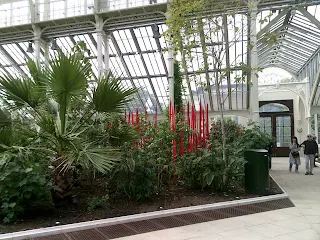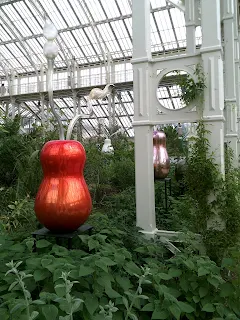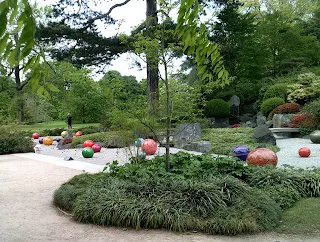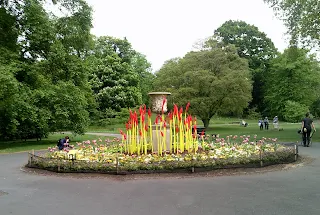I was under the mistaken notion that this would be a small blog, as I've been to Kew Gardens before- but that was before I noted how many photographs I'd taken!
For this blog, I'm going to try and concentrate on showing you the sculptures of the Dale Chihuly exhibition, which are dotted around these magnificent gardens. I'm also going to add a few photos of inside Kew Palace, as it's the first time I've been inside and photography's been allowed.
Here is the link to last year's visit, which is mainly about the newly-restored Pagoda and Temperate House:-
...And here is the link to my 2017 visit, by myself as my SuperDean was too unwell to attend:-
Dale Chihuly (born 1941, in Washington, USA) is an American artist who specialises in sculptures of blown glass and steel, on a grandiose scale. They certainly made an impact on Kew Gardens and worked in harmony with the surroundings. I loved the juxtaposition of the man-made and modern with the centuries-old trees and quaint (albeit restored, in the case of the Temperate House) glasshouses.
For those of you who are interested, here's the promotional poster as you enter...
The Palm House with one of Chihuly's 'squiggles' in the shot, to the right...
I made some friends, in the shape of geese. It was a warm but overcast day, and the orange sculpture certainly brightens up this picture. I've been told that geese are evil (especially Canada Geese, seen here at the front!) These just seemed interested in my food...
I think the stone lions look so majestic. Maybe I like them because my star sign is Leo?!😁
This face is nothing to do with the exhibition- I just like it...
Outside the Waterlily House...
Closer...
Inside the Waterlily House was possibly my favourite installation...
My only moan was that the real waterlilies had been taken away, and didn't seem to be in the Princess of Wales Conservatory either...
On the way to the Marianne North Gallery, behind the Palm House, we encountered this spiky sculpture...
This lime and lemon piece was right by the Marianne North Gallery. Whilst I loved Chihuly's work, she is possibly my most favourite artist...
Beautiful natural and man-made purple (my favourite colour😁) outside King William's Temple...
Squiggly reeds...
King William's Temple...
A sweeping view down to the Temperate House...
Close-up of red squiggles amongst the tulips...
The Temperate House...
This yellow and white affair reminded me of a weird, inverted ice cream cone...
This blue delight hung inside the Temperate House...
These green reeds kind of peeped out at you from amongst the foliage. These were the most camouflaged pieces...
This white sculpture reminded me of a Protea flower...
Yellow straight and bendy bits...
Red playing peekaboo amongst the green...
Ooooooh, what a lovely pair!😂😂
Actually, I don't even know if they're supposed to be pears- but they brought out the Carry On humour in me!
Balls! This was possibly my second-favourite sculpture...
As we left the greenhouse, this spiky yellow thingy was hanging from the roof...
Beautiful Strelitzia, named after Mecklenburg-Strelitz, the birthplace of Queen Charlotte (George III's consort).
They reminded me of a billiard table...
My favourite photo of the day, showing the Pagoda...
The last time I was here the table was set for dinner, with plastic imitations of food...
I told you the palace was a work in progress...
The Temple of Bellona, and our final sighting of a Dale Chihuly sculpture...
I had a lovely day, and would certainly love to return whilst the sculptures are still in place. I believe the exhibition continues until October, so I will pop back at the end of the summer.
TTFN
The Miss Elaineous
XXXXXXXXXXXXXXXX
XXXXXXXXXX
XXX
X
This was in the small glasshouse next to the Temperate House. There are several of them dotted around, designed by kids. They remind me of works by Jean-Michel Basquiat!
More balls, in the Zen Garden, behind the Japanese Gateway...
They reminded me of a billiard table...
My favourite photo of the day, showing the Pagoda...
We rarely pop over to the lake, so we made a point of doing so and taking a walk over the Sackler Crossing. This bridge was opened in 2006.
Views from the bridge...
As always whilst at Kew, I was reminded that we were on the Heathrow flight path...
Walking round from the other side of the Palm House, and here's the original squiggle...
Red reeds...
The Secluded Garden...
The Hive was closed for maintenance. But I didn't care as I've been inside a couple of times before...
The inside of the Ice House is not large, and I've photographed it before. But I liked these pictures of the way in...
Kew Palace...
History:
Dating back to 1631 and built on top of the undercroft of an earlier construction, the only remaining building of what was once a complex is the Dutch House we see today. Its royal occupation lasted from around 1728 to 1818, with a brief, short lived revival in 1844.
Originally occupied by Prince Frederick (father of George III), he took a long lease on a house called Capel Lodge, and began remodelling the gardens. He died in 1751 and his widow, Augusta, continued to stay at the house and develop the gardens. It became known as the White House, due to its plaster exterior. George III and his brother, Edward, were educated in the nearby Dutch House. Frederick had also added the kitchen block, open today and known as the Royal Kitchens.
King George was kept in the White House during his first bout of 'madness', from 1788-89, with his wife Charlotte and daughters living on the upper floors. It was then allowed to fall into disrepair, although it was still in a decent enough state to house George during his second bout of madness, in 1801.
The White House was demolished in 1802, and during the onset of George's third bout of madness, in 1804, he was housed in a service wing of the Dutch House and possibly the ground floor of the Dutch House, with Queen Charlotte and her daughters living on the first and second floors. The service wing was mostly demolished in 1881, but was originally connected to the west side of the Dutch House.
Queen Victoria briefly sent her children to live there, in 1844. She transferred it, and Queen Charlotte's Cottage, to Kew Gardens to celebrate her Golden Jubilee. It remained open to the public until closing to undergo a major restoration, beginning in 1996 and opening ten years later, in 2006. It is still a work in progress.
When I entered, I was told that photography without a flash was allowed, whereas it hadn't been before, and I just HAD to take advantage. These photos were rushed, as I'd left my SuperDean in the Alpine House as he needed to rest, and my five minute sneak-off became half an hour...😉
This was the Breakfast Room...
The King's Dining Room...
The last time I was here the table was set for dinner, with plastic imitations of food...
The Queen's Boudoir...
The Queen's Drawing Room...
Mirror mirror, on the wall...
Princess Elizabeth's Bedchamber...
These shots in in Princess Elizabeth's Bedchamber show the thickness and construction of the walls...
Of course, we have to have a Vain Old Tart photo...
Queen Charlotte's Bedchamber...
Queen Charlotte's Antechamber...
I told you the palace was a work in progress...
Princess Amelia's Bedroom...
Princess Augusta's Bedroom. The top floor is in rather a sad state...
The royal khazi...
Staircase...
First floor corridor...
The view over the replica 17th century Dutch Garden. This was created in 1969...
I made my way back to my SuperDean, sitting in the Rock Garden. Here are some of its relaxing, tinkling waterfalls...
Eduardo Luigi Paolozzi (1924-2005) was a Scottish sculptor and artist, and the son of Italian immigrants.
This is called 'A Maximus Ad Minima'. Translated it means 'From the greatest (things) to the least'. It is dated 1998.
The Temple of Bellona, and our final sighting of a Dale Chihuly sculpture...
I had a lovely day, and would certainly love to return whilst the sculptures are still in place. I believe the exhibition continues until October, so I will pop back at the end of the summer.
TTFN
The Miss Elaineous
XXXXXXXXXXXXXXXX
XXXXXXXXXX
XXX
X










































































